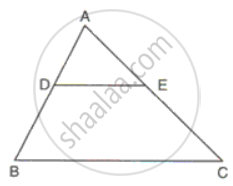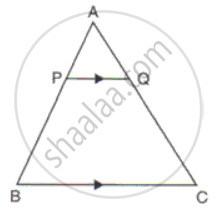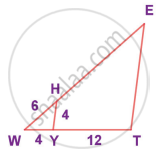Advertisements
Advertisements
प्रश्न
In ΔABC, DE is parallel to BC and DE = 3:8.
Find:
(i) AD : BD
(ii) AE, if AC = 16.
उत्तर
(i) Since DE ||BC
`"DE"/"BC" = "AD"/"AB"`
⇒ `(3)/(8) = "AD"/"AB"`
⇒ `"AD"/"AB" = (3)/(8)`
Since DB = AB - AD
⇒ DB
= 8 - 3
= 5
Therefore,
AD : DB = 3 : 5
(ii) DE : BC = 3 : 8
Since DE || BC
`"DE"/"BC" = "AE"/"AC"`
⇒ `(3)/(8) = "AE"/(16)`
⇒ AE = `(3 xx 16)/(8)`
⇒ AE = 6.
APPEARS IN
संबंधित प्रश्न
In ∆ABC, DE is parallel to base BC, with D on AB and E on AC. If `\frac{AD}{DB}=\frac{2}{3}` , find `\frac{BC}{DE}.`
State, true or false:
All equiangular triangles are similar.
Δ ABC ∼ Δ PQR such that AB= 1.5 cm and PQ=2. 1 cm. Find the ratio of areas of Δ ABC and ΔPQR.
The scale of a map is 1 : 200000. A plot of land of area 20km2 is to be represented on the map. Find:
The number of kilometres on the ground represented by lcm or the map
In figure, PQ is parallel to BC, AP : AB = 2 : 7. If QC = 0 and BC = 21,
Find
(i) AQ
(ii) PQ
A model of a ship is made to a scale of 1:500. Find: The length of the ship, if length of the model is 1.2.
Two triangles QPR and QSR, right angled at P and S respectively are drawn on the same base QR and on the same side of QR. If PR and SQ intersect at T, prove that PT × TR = ST × TQ
In any triangle _______ sides are opposite to equal angles
In the given figure YH || TE. Prove that ΔWHY ~ ΔWET and also find HE and TE
If ΔABC ∼ ΔDEF and ∠A = 48°, then ∠D = ______.
